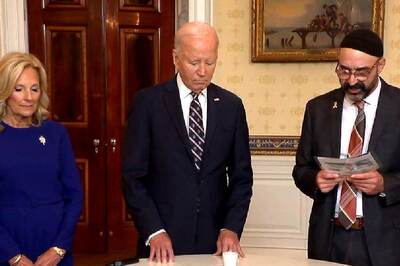
views
Naxalbari: The inability of elephants to understand political boundaries of nation states and an 18 kilometer electrical fence along the Nepal border are at the heart of discontent in several key villages in the election-bound Darjeeling Lok Sabha.
For over a century, elephants have used a route along the banks of the river Mechi that separates India and Nepal. The elephants, the Indian forest department said, would use the route to travel to Nepal at night and feast on agricultural fields during the harvest season. In 2015, the Nepal government, with the aid of the World Bank, set up an electric fence that would prevent the elephants from crossing over to Nepal.
Although human-elephant conflict isn’t new in the terai region. LSS O’Malley,the author of the Bengal District Gazeteer, had noted that the region had a “melancholy record of persons killed, crops destroyed and villages ruined”.. The elephants, faced with a fence designed specifically to keep them out, turned towards India, in particular villages such as Changa, Surajbar, Amarsing and Marapur.
In the past three years, human-elephant conflict has claimed 1,713 human and 373 elephant lives. That is nearly one elephant being electrocuted, poached, stabbed or burnt every three days and approximately three people killed every two days. Of this, it is Bengal, with 307 deaths in the past three years that is the capital of the man-elephant conflict in the country. Adjacent Odisha, with 305 deaths, is a close second. This, is as per the information that Mahesh Sharma, MoS for the Ministry of Environment and Forest, presented in the Parliament earlier this year.
The view from the villages
These villages go to poll on April 18 and here too, the conversation about elephants and the resultant conflict is being viewed through a Modi-versus-Mamata matrix. In 2016, the forest minister Binay Krishna Barman had held a meeting with the forest department in Darjeeling and brought up the fence along the border. Following the meeting, officials said, the state government had repeatedly written to the Centre but to no avail. “We had asked the Centre to take up the issue with Nepal, via diplomatic channels. It has been almost four years now but nothing has changed,” said an official.
At Surajbar, Bishnu Tamang (42), a farmer said, “Mamata Banerjee had asked PM Modi to intervene and said that these were the real issues of the people. But nothing happened.” Soma Murmu (67) said, “The state government hasn’t cared at all. Even when the crops are destroyed, we don’t get the compensation on time.”
Avijan Saha, a wildlife expert, said, “One remarkable thing about the area is the relationship that people have with the elephants. If we ask, who does the elephant belong to, there are those who say that the elephant belongs to all of us, to society. But then there are others who view the elephant as belonging to the state government.”
Meanwhile in Nepal, these elephants are decidedly viewed as belonging to India. The fence, the forest department in Darjeeling told News18, occupied a near hallowed position. “And why wouldn’t they. There are poor farmers on both side and forests have nearly disappeared. So the elephants come raid crops and then these farmers don’t know what to do. There were very serious cases of poaching on the Nepalese side as well as a result of the conflict,” said an official.
The corridor had also been identified by the 2005 edition of ‘Rights of Passage’, a 2005 study by the Ministry of Environment and Forests and WTI as the Mahananda-Kolbari elephant corridor. “Severe fragmentation and degradation of forest in Tukriajhar and along the Mechi River has made this habitat unsuitable for the long-term survival of elephants and has increased conflict,” the study had noted. “Hence, efforts should be made to restrict the movement of elephants beyond the Balason River.” The study recommended the declaration, demarcation and legal protection of the corridor, but this resulted in little action on the ground, admitted officials.
Elephants and Politics
Bengal is no stranger to conflict with elephants. But the forest department officials said that such incidents have been more concentrated in Mednipur, Bankura and Purulia where the political impact had also traditionally been localised. While the increased incidents of conflict cases in north Bengal potentially changes this, the rise of such cases in the first place is also intrinsically linked to politics, particularly the land reforms in the state that arguably changed its politics forever.
Along with the land reforms movement that distributed “waste land” or “unutilised land” to the landless/agricultural labourers on a long term lease, another World Bank aided project - the Social Forestry Project was started in 1981. A 2014 study, Time Series Analysis of Forest and Tree Cover of West Bengal from 1988 to 2010, using RS/GIS, for Monitoring Afforestation Programmes' published in The Journal of Ecology noted that with the success of the group farm forestry in south Bengal districts of east and west Mednipur, Bankura and Purulia, “the characters of such apparent wasteland started changing into more productive land with better soil moisture; better soil organic content and these lands became less prone to drought.”
This changed scenario, coupled with less impetus on the government sponsored programme for social or farm forestry in the past decade led to the diversion of tree plantation areas on private land to more attractive agricultural or vegetable cultivation, while the forest cover outside forest land also suffered a setback, noted the study. This, the study points out, had a direct bearing on man-elephant conflict.
“During the period September to January every year from 1987 onwards, herds of wild elephants migrate to this part of the State from adjoining Dalma forest areas in the State of Jharkhand and the forests of Odisha. They cause damages worth millions of Indian rupees to the crops. If the villagers can be encouraged to go for Farm Forestry with fast-growing and economically viable tree crops, such damages to agricultural crops by wild elephants can be brought down substantially,” said the study.


















Comments
0 comment